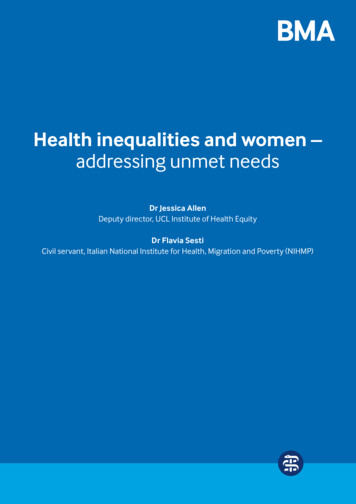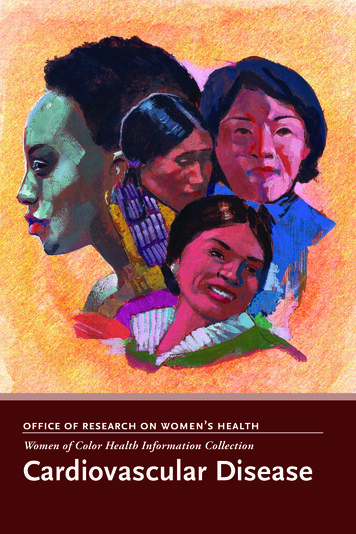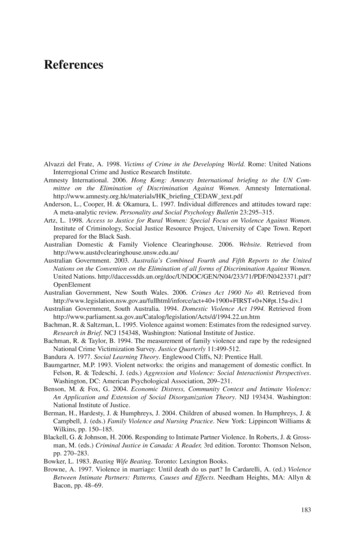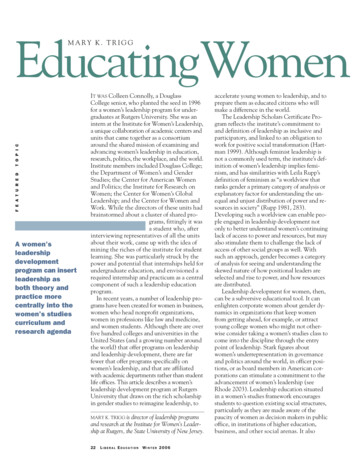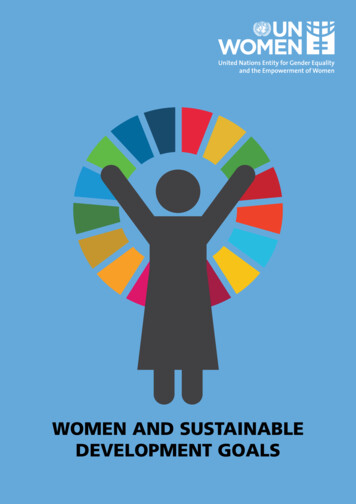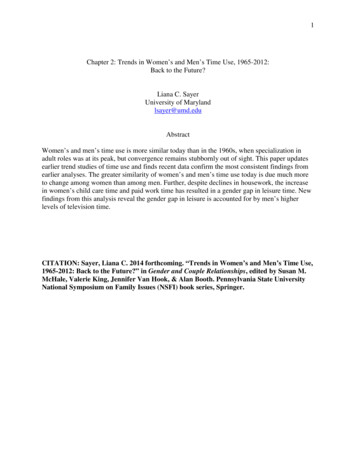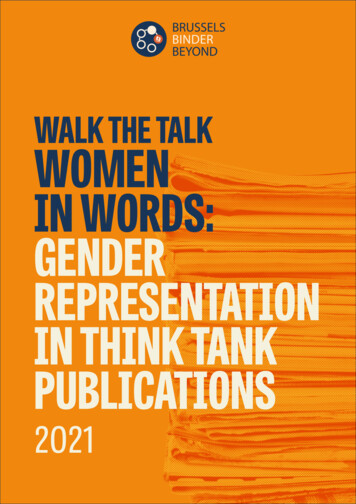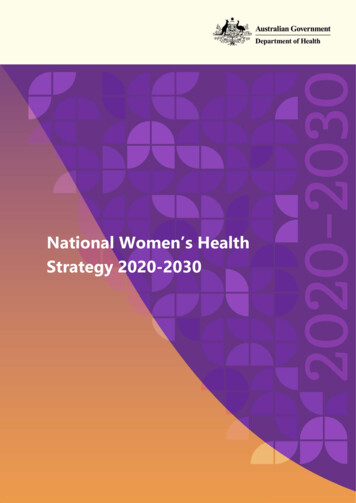
Transcription
National Women’s HealthStrategy 2020-2030
Commonwealth of Australia as represented by the Department of Health 2018Creative Commons LicenceThis publication is licensed under the Creative Commons Attribution 4.0 International Public License available galcode (“Licence”). You must read and understand the Licence before using anymaterial from this publication.RestrictionsThe Licence may not give you all the permissions necessary for your intended use. For example, other rights (such as publicity, privacyand moral rights) may limit how you use the material found in this publication.The Licence does not cover, and there is no permission given for, use of any of the following material found in this publication: the Commonwealth Coat of Arms (by way of information, the terms under which the Coat of Arms may be used canbe found on the Department of Prime Minister and Cabinet lth-coat-arms);any logos and trademarks;any photographs and images;any signatures; andany material belonging to third parties.AttributionWithout limiting your obligations under the Licence, the Department of Health requests that you attribute this publication in yourwork. Any reasonable form of words may be used provided that you: include a reference to this publication and, where practicable, the relevant page numbers;make it clear that you have permission to use the material under the Creative Commons Attribution 4.0 InternationalPublic License;make it clear whether or not you have changed the material used from this publication;include a copyright notice in relation to the material used. In the case of no change to the material, the words “ Commonwealth of Australia (Department of Health) 2018” may be used. In the case where the material has beenchanged or adapted, the words: “Based on Commonwealth of Australia (Department of Health) material” may beused; anddo not suggest that the Department of Health endorses you or your use of the material.EnquiriesEnquiries regarding any other use of this publication should be addressed to the Branch Manager, Communication Branch, Departmentof Health, GPO Box 9848, Canberra ACT 2601, or via e-mail to copyright@health.gov.au National Women’s Health Strategy 2020-2030 2
Minister’s forewordAustralia can rightly be proud of our nation’s health services and of the health and longevity of bothwomen and men in our communities. However, we cannot be complacent as there are both ongoing andnew health and wellbeing challenges that we face.Importantly, recognising and responding to the differences in health outcomes—between women andmen and between different groups of women and girls within our population, must be an ongoing focusof our efforts. Enabling women and girls to have access to support for their particular health issues andneeds will help to improve the health of our nation.This is a strategy for all women and girls. It has been developed by and for all women. It recognises thatwomen have both general population and specific health needs.In 2018, I proposed the establishment of a new strategy to build on the National Women’s Health Policyreleased in 2010. The years since 2010 have seen important changes in medicine, in health technologiesand in society which have had positive impacts on our capacity to respond to the health needs of womenand girls.This National Women’s Health Strategy for 2020-2030 is the result of consultations with women from allwalks of life, organisations representing disadvantaged groups, medical associations and with policymakers. Their diverse perspectives, experience and knowledge are valued and respected and I greatlyappreciate their contribution.The Strategy identifies policy gaps and new and emerging health issues for women and girls. It presentsrecommendations for action and highlights the need for collaboration between partners, includinggovernments at all levels, the health sector, relevant organisations and women themselves. It outlines theimportance of directing health system resources towards addressing the health issues affecting womenand girls, from preconception to end of life.The health of women and girls in Australia is fundamental to us all, to the individuals themselves, to theirfamilies and communities and to our nation. I am very pleased that this new Strategy could help allwomen and girls to enjoy the best possible mental and physical health through their lifetimes.SincerelyThe Hon Greg Hunt MPMinister for Health National Women’s Health Strategy 2020-2030 3
AcknowledgementsWe acknowledge the advice and support of the many organisations and individuals that have contributedto the development of this Strategy. These include (but are not limited to) all participants at the NationalWomen’s Health Forum, state and territory governments, those that provided submissions through theonline consultation process and our group of experts who provided technical advice on the draft Strategy.Expert Advisory Group members:Ms LaVerne Bellear, National Aboriginal Community Controlled Health OrganisationProfessor Susan Davis, President, International Menopause SocietyA/Prof Anita Ghose, University of Notre DameMs Emma Lonsdale, EO, Chronic Disease Prevention AllianceMs Christine Morgan, CEO, Butterfly FoundationDr Vijay Roach, President, Royal Australian and New Zealand College of Obstetricians and GynaecologistsA/Prof Ruth Stewart, President, Australian College of Rural and Remote Medicine National Women’s Health Strategy 2020-2030 4
ContentsMinister’s foreword . 3Acknowledgements. 4Contents . 5Executive summary . 6Strategy overview . 7About the Strategy . 8The Strategy in context . 8International context . 8The health of women and girls in Australia . 10Factors contributing to health and health outcomes for women and girls . 10Women’s health at a glance . 11A life course approach . 12Improving health equity for women and girls . 14Priority groups among women and girls in Australia . 14The health of Aboriginal and Torres Strait Islander women and girls . 16Sex and gender diversity . 16What women want . 17Principles and Objectives . 18Priority areas . 21Priority area 1 – Maternal, sexual and reproductive health . 22Priority area 2 – Healthy ageing . 27Priority area 3 – Chronic conditions and preventive health . 30Priority area 4 – Mental health . 35Priority area 5 – Health impacts of violence against women and girls . 41Investing in research . 44What will be different . 44Strengthening Partnerships . 48Achieving progress . 49Appendix A Related policy and strategy documents . 50Appendix B References . 52 National Women’s Health Strategy 2020-2030 5
Executive summaryThe National Women’s Health Strategy 2020-2030 (the Strategy) outlines Australia’s national approach toimproving health outcomes for all women and girls in Australia. Building on the overarching NationalWomen’s Health Policy 2010, the Strategy takes account of the changes in the policy environment,considers the latest evidence and identifying the current gaps and emerging issues in women’s health. Itaims to inform targeted and coordinated action at the national and jurisdictional levels to address thepriority health needs of women and girls in Australia.The Strategy outlines key health risks and issues for women and girls in Australia. It highlights the range offactors, such as biomedical, behavioural, social, economic and environmental influences, that contribute tohealth outcomes; and key health inequities such as access to services, health literacy, stigma and genderinequality, that are experienced by many women and girls. Acknowledging the unique needs of differentpopulation groups is a key element of the Strategy, with priority populations recognised and targetedinterventions identified to improve health outcomes.Through a life course approach, the Strategy recognises there are a range of health needs, risks andinfluences experienced by women at different stages of life, and focuses on the importance of investing inawareness and education, health interventions, service delivery and research at these key stages tomaximise physical, mental and social health at every age.The principles and objectives of the Strategy provide a frame for both the development of the Strategyitself and to guide the subsequent implementation of priorities and actions outlined in the Strategy.Key priorities and actions have been developed to drive change and improve health outcomes. The fivepriority areas are:1.Maternal, sexual and reproductive health – increase access to information, diagnosis, treatmentand services for sexual and reproductive health; enhance and support health promotion andservice delivery for preconception, perinatal and maternal health.2.Healthy ageing – adopt a life course approach to healthy ageing; address key risk factors thatreduce quality of life and better manage the varied needs of women as they age.3.Chronic conditions and preventive health – increase awareness and prevention of chronicconditions, symptoms and risk factors; invest in targeted prevention, early detection andintervention; tailor health services for women and girls.4.Mental health – enhance gender-specific mental health awareness, education and prevention;focus on early-intervention; invest in service delivery and multi-faceted care.5.Health impacts of violence against women and girls – raise awareness about, and address thehealth and related impacts of violence against women and girls; co-design and deliver safe andaccessible services.The improvement of health outcomes for women and girls is strongly influenced by the contributionsmade by a wide range of partners. These partners include: individuals, carers and families;communities;all levels of government;non-government organisations;the public and private health sectors, including health care providers and private health insurers;industry; andresearchers and academics.Greater cooperation between partners will lead to more successful individual and system outcomes. Thepriorities and actions outlined in this Strategy are intended to guide partner investment in activities toaddress the health of women and girls and should be implemented collaboratively to achieve the besthealth outcomes. National Women’s Health Strategy 2020-2030 6
Strategy overviewFigure 1: Overview of the National Women’s Health Strategy 2020-2030Click to view the text version of Figure 1 National Women’s Health Strategy 2020-2030 7
About the StrategyThe health of our nation depends on the combined and individual health of Australians. Recognising thatwomen’s experiences of mental and physical illness are different from men’s is essential for developingservices that are effective in addressing the health needs of women and girls in Australia.The Strategy has been developed through a consultative process that considered the latest evidence inrelation to women’s health and drew on the input and opinions of leading Australian health experts,members of the health sector and the wider community.The Strategy aims to drive continuing improvement in the health and wellbeing of all women in Australia,particularly those at greatest risk of poor health. It identifies specific actions to address the health issuesthat affect women and girls throughout their lives and aims to reduce inequities in health outcomesbetween men and women, and between sub-population groups of women and girls.To improve the overall health and wellbeing of all women and girls in Australia, they need to be informedand empowered to be part of the decision-making process. The Strategy recognises that a woman’s needswill vary according to her physical, emotional, socioeconomic and cultural circumstances.The Strategy in contextThe National Women’s Health Strategy is an overarching document designed to complement and alignwith other health-related policies and strategies. It is designed to provide a gender-specific approach toactivities already underway and to guide the development of new and innovative policies and approachesaimed at addressing the specific health needs of women and girls in Australia. Figure 2 provides anoverview of the Australian context for women’s health, with a more detailed list of complementary policydocuments provided at Appendix A.The Strategy works in tandem with the National Men’s Health Strategy 2020-2030. The aim of thesestrategies is to acknowledge the different biological and societal factors that impact women’s and men’shealth and wellbeing, and to strengthen and improve national approaches for both.International contextThe Strategy acknowledges the broader international health policy context for women’s health. As amember state of the World Health Organisation (WHO), Australia has endorsed the adoption of the UnitedNations 2030 Agenda for Sustainable Development and its seventeen Sustainable Development Goals(SDGs). 1 Within the health context, there is a particular focus on SDG3, SDG5 and SDG10, relating to goodhealth and well-being, achieving gender equality and reducing inequalities, respectively.The Strategy also aligns with the WHO Global Strategy for Women’s, Children’s and Adolescents’ Health(2016-2030) and the overarching objectives of the associated Survive, Thrive, Transform, to save the livesand improve the well-being of every woman, child and adolescent. 2Australia is an active member of the Organisation for Economic Co-operation and Development (OECD) byboth contributing to the organisation’s work and utilising the research and recommendations produced toinform policy development. The OECD Health Indicators 3 related to health system performance and theinternational comparison of the health of Australians have been considered in the development of theStrategy. National Women’s Health Strategy 2020-2030 8
Figure 2: Overview of the strategic policy context for women’s healthClick to view the text version of Figure 2 National Women’s Health Strategy 2020-2030 9
The health of women and girls in AustraliaMuch has changed for women since the release of the first National Women’s Health Policy nearly 30years ago. Societal shifts, as well as changing lifestyles and habits, continue to have a significant impact onthe health and wellbeing of women and girls in Australia.In global terms, Australian women and girls experience strong health outcomes – for example, anAustralian girl born during the period 2014-16 can expect to live to nearly 85 years, 4 which sees Australiahaving the eighth highest female life expectancy when compared with 35 member countries of the OECD. 5However, there is a need to reduce the burden of disease and improve quality of life for women and girlsby; improving sexual and reproductive health, ensuring we provide the best possible care for an ageingfemale population, combatting high rates of chronic conditions and mental ill-health, and addressing thehealth impacts of violence.Factors contributing to health and health outcomes forwomen and girlsWomen’s health experiences and outcomes, like that of the population more broadly, are largely shapedby biomedical, behavioural and non-modifiable risk factors together with a broad range of social,economic and physical environment determinants. 6 Biomedical risk factors relate to the condition, state or function of the body that contributes tohealth outcomes, such as medically significant obesity. Behavioural risk factors can have positive or negative impacts on health. Physical activity andhealthy eating habits reduce the risk of poor health, whereas risk factors such as smokingtobacco, alcohol and/or illicit drug misuse, or exposure to violence, may increase the likelihood ofpoor health. 7 Non-modifiable risk factors affecting women and girls can be genetic, such as hereditary breastcancers relating to an inherited genetic mutation. Social and economic determinants are difficult for individuals to control, however they impacthow women and girls live their lives. Physical environment determinants consider both the natural and built environment in whichwomen and girls live.While these risk factors and determinants of health are common to both genders, some appear to have agreater influence on health outcomes for women than men, and it must be recognised that thepresentation of some health conditions – for example, cardiovascular disease, may be influenced bygender. 8The context of women’s lives – including gender, age, ethnicity, sexuality, disability, geography, educationand literacy, socioeconomic status, employment status and work conditions – can shape health outcomesby influencing access to health care and experiences of health, wellbeing, illness and death. 9 National Women’s Health Strategy 2020-2030 10
Women’s health at a glanceFigure 3: A snapshot of key health risks for women and girls in Australia. 10 11 12 13 14Click to view the text version of Figure 3 National Women’s Health Strategy 2020-2030 11 15 16 17
A life course approachThe Strategy proposes a comprehensive approach to improving women’s health across the life course,recognising that women and girls can experience a range of diverse health needs and risks across theirlifespan, and a person’s health at each stage of life affects health at other stages. 18 Different stages of lifecan trigger points of intersection between health, mental health and social and emotional wellbeing. Theselife stage intersections provide a potential patient-centred platform for governments, stakeholders,organisations and representative bodies to work together to plan and deliver better coordinated andfocused programs to reduce health inequities.To increase the effectiveness of health education, intervention and service delivery, there needs to be astrategic focus on these intervention points across the life course. Awareness and education campaigns,health services delivery and research investments need to be age appropriate, based on gender equity,and integrated to respond to women’s changing mental and physical health needs.The Strategy acknowledges that the life course for Aboriginal and Torres Strait Islander women and girls isdifferent from non-Indigenous women and girls, which in turn influences the potential points ofintersection. This is addressed in greater detail through the Implementation Plan for the NationalAboriginal and Torres Strait Islander Health Plan 2013-2023 and the National Strategic Framework forAboriginal and Torres Strait Islander Peoples’ Mental Health and Social and Emotional Wellbeing 2017-23.Figures 4 and 5 provide an overview of the leading causes of total burden of disease, and the changinghealth needs, risks and intervention points, across each stage of women’s lives.Figure 4: Total burden of disease across the life course19GirlsAdolescents andyoung womenAdult womenOlder womenBirth to 5 years:15 to 24 years:25 to 44 years:65 to 74 years:Infant and congenitalconditions account for alarge portion of theburden in this age group.This is mostly due topre-term/low birthweightcomplications, birthtrauma and asphyxia andother disorders ofinfancy.Anxiety disorders,depressive disorders andasthma continue to leadthe cause of diseaseburden.Anxiety and depressivedisorders are leading nonfatal disease burden.‘Other’ musculoskeletalconditions, osteoporosis,back pain and problemsalong with osteoarthritisand rheumatoid arthritisare the leading causes ofnon-fatal burden.5 to 14 years:Young women are atgreater risk of experiencingviolence.Anxiety disorders,asthma and depressivedisorders are the leadingcauses of burden inyoung girls. National Women’s Health Strategy 2020-2030 Suicide/self-inflictedinjuries and motor vehicleaccidents are the leadingcauses of fatal burden.Burden due to intimatepartner violence washighest among womenaged 40 to 44 years.Suicide/self-inflictedinjuries and breast cancerare the leading causes offatal burden.45 to 64 years:‘Other’ musculoskeletalconditions, osteoporosis,back pain problems,anxiety disorders, breast,lung and bowel cancers,COPD and coronary heartdisease are the leadingcauses of total burden. 12 Lung, breast and bowelcancers, alongsidecoronary heart disease,are the leading causes offatal burden.75 years and older:Dementia and coronaryheart disease, hearingand vision disorders,various musculoskeletalconditions andosteoporosis increasinglyaccount for the totalburden of disease.
Figure 5: Health focus and key intervention points across the life courseGirlsAdolescents andyoung womenEarly development ofhealth literacy andhelp-seeking behavioursare critical to establishinggood health habits forlife.This is a critical time foreducation and awarenessaround resilience,respectful relationshipsand sexual andreproductive health.Establishing healthyeating habits inpre-adolescent years,and regular engagementin physical activity, giveslife-long health benefits.Establishing earlyconfidence in, andrelationships with, primaryhealth care providers is animportant foundation forhealth literacy andhelp-seeking behaviours.Poor mental and physicalhealth can meanlong-term risks for laterin life.Early detection andintervention for girlsexperiencing child abuseis essential for futurehealth and wellbeing.20 21 22 23 24Adult womenOlder womenHealthy lifestyles andhelp-seeking behavioursare significantly influencedby sociodemographicfactors and habitsdeveloped duringchildhood andadolescence.Support women to agewell within theircommunities and theirown homes by buildingand sustainingcommunity networks;focus on preventableconditions and socialdeterminants to helpwomen maintain theirindependence.Women are at increasedrisk of experiencing mentalill-health during pregnancyand the year followingchildbirth.Vulnerable years for healthrisks, poor mental health,body dissatisfaction,preconception health andlifelong health behaviours.Menopause transition canaffect women’s physicaland mental health andincreases risk for futurecardiometabolic health.Peer influence, early sexualrelationships, abusiverelationships, culturalpressures and societalmessaging adverselyimpact health.Abusive relationships placewomen at risk ofpremature death andincreased physical andmental ill health.Older women, who havedisproportionatelyhigher rates of chronicconditions, aredisproportionatelyrepresented in the agedcare population.Older women withchronic conditions aredisproportionatelyrepresented in the agedcare populationOlder women are atincreased risk ofexperiencing lonelinessand social isolation;which is linked todepression, dementia,and premature mortality.Elder abuse, physicalinactivity and financialinsecurity are significantcontributors forincreased health risks. National Women’s Health Strategy 2020-2030 13
Improving health equity for women and girlsThrough the consultation process, a number of themes emerged as areas to focus on for improving healthequity. These include:Increase access toservicesImprove healthliteracyAcknowledgecultural impactsBreak the ‘cycle ofinvisibility’Reduce stigmaReduce racismReduce genderinequality Barriers can be physical, geographic, financial, educational or cultural Low health literacy levels can result in less access to services, less understandingof issues related to health, poorer health management and social isolation Cultural determinants of health are important for Aboriginal and Torres StraitIslander women and girls, as a ‘strong connection to culture is strongly correlatedwith good health, through strengthened identity, resilience and wellbeing’ 25 Information not captured in national health data collection, such as sexualvariation, or gender disaggregation in research, results in specific groups beinginvisible in health care design and delivery. This in turn, negatively impacts onhealth outcomes for these groups, perpetuating the ‘cycle of invisibility’ Stigma and discrimination experienced by some population groups, and acrosscertain health issues, is inextricably linked to poorer health outcomes Institutional and individual prejudice experienced by Aboriginal and Torres StraitIslander women and girls, and some culturally and linguistically diversepopulation groups, is contributing to poorer health outcomes Women carry a disproportionate burden of care and often do not prioritise theirown health needs. Additionally, gender pay gaps and less time spent in theworkforce can lead to lower retirement incomes, financial insecurity andincreasing rates of homelessness for older womenPriority groups among women and girls in AustraliaThere is no true ‘average’ woman in Australia, women and girls are diverse in age, social and economiccircumstances, the type of work undertaken, as well as culture, language, education, beliefs and a range ofother factors that can influence health behaviours and outcomes. Each individual has unique and oftencomplex health needs, shaped by the context in which they live.Addressing inequities in health care, between and within population groups, is a key focus of the Strategy.While there have been improvements in the lives and health of women and girls in Australia over the lastdecade, with a reduction in smoking and alcohol consumption and in death rates from some cancers, 26many women remain disadvantaged, with greater health needs, lower access to quality health care andpoorer health outcomes.Many women and girls fall into more than one of the identified priority population groups and this canhave a compounding effect on health needs and outcomes. For example, many women and girls fromrural and remote backgrounds also have a lower socioeconomic status, may identify as Aboriginal andTorres Strait Isla
5. Health impacts of violence against women and girls - raise awareness about, and address the health and related impacts of violence against women and girls; co-design and deliver safe and accessible services. The improvement of health outcomes for women and girls is strongly influenced by the contributions made by a wide range of partners.
